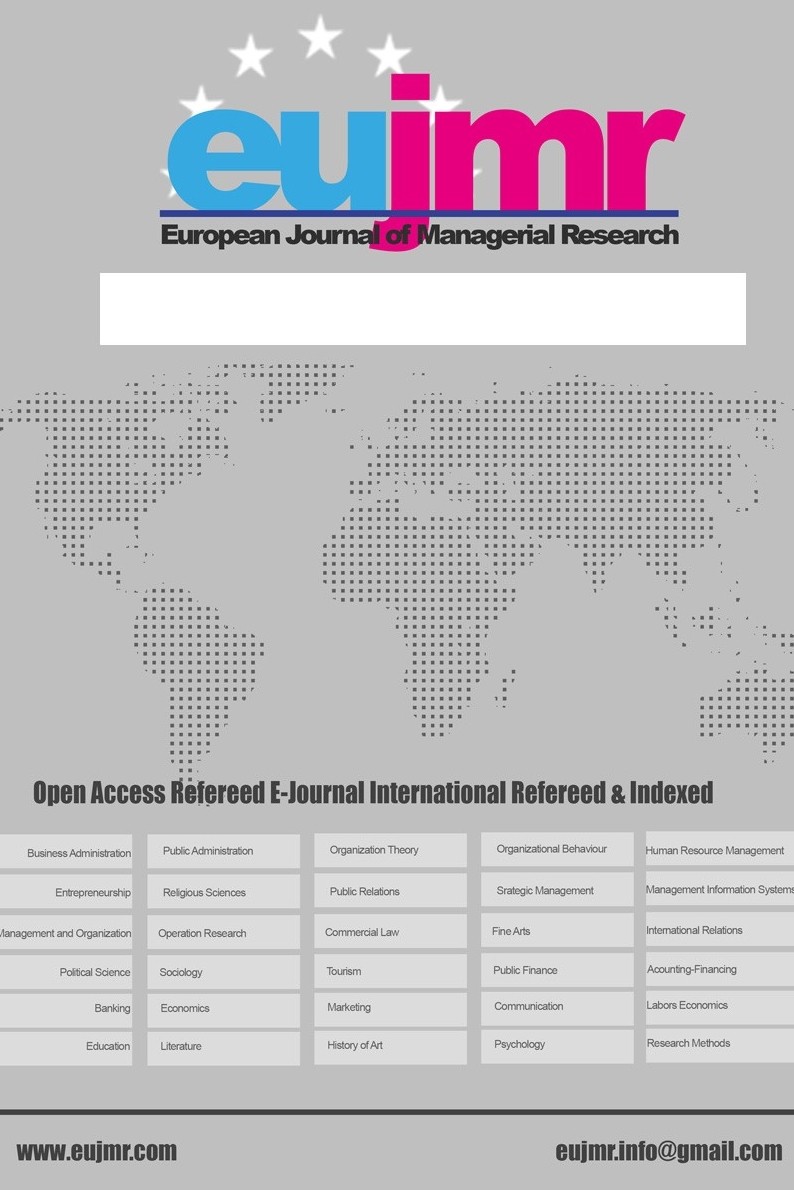SEASONAL ERROR CORRECTION MODELS FOR MACROECONOMIC VARIABLES: THE CASE OF TURKISH ECONOMY
In this research, it has been aimed to examine seasonal long-term relationships and to estimate seasonal error correction model (SECM) which is the second step in the presence of cointegrating relationships for quarterly Gross Domestic Product (GDP), Gross Fixed Capital Formation (INV), Imports (IMP), Consumption of Resident Households (CONS) and Government Final Consumption Expenditures (GOV) variables for Turkey covering 1998Q1-2017Q3 period. HEGY(1990) approach has been utilized for seasonal unit root analyses and seasonal error correction mechanisms have been estimated based on the study of Engle, Granger, Hylleberg, Lee (EGHL) (1993). Findings have revealed that when dependent variable is INV, SECM(3) has worked at 1/2 frequency and 38.9% of deviations from long-run equilibrium in INV variable will be corrected at one period. Based on SECM(2) estimation at ½ frequency, 30.9% of deviations from IMP will disappear at one period under 10% significance level. At ¼ frequency, SECM(1) results for GOV and CONS dependent variables have shown that approximately 55% of deviations from long-run equilibrium in both variables will disappear at one period. ECM has not worked for dependent variable “GOV” at ¾ frequency depending upon the positive value of error correction term. Additively, SECM(2) has been working at ¼ frequency for dependent variable “IMP”.
Anahtar Kelimeler:
EGHL, Gross Domestic Product, HEGY, Seasonal Cointegration, Seasonal Error Correction Model
___
- Cubadda, G. (2001). Complex reduced rank models for seasonally cointegrated time series. Oxford Bulletin of Economics and Statistics, 63(4), 497-511.
- Diaz-Emparanza, I., & López-de-Lacalle, J. (2006). Testing for unit roots in seasonal time series with R: The uroot package. Retrieval Date: 10 May 2015, http://www.jalobe.com:8080/doc/uroot.pdf.
- Eberl, K. (1998). Seasonal cointegration analysis of German money demand using simple-sum and divisia monetary aggregates. Diskussionsbeiträge der Katholischen Universität Eichstätt, Wirtschaftswissenschaftliche Fakultät Ingolstadt, 107.
- Engle, R. F., & Granger, C. W. J. (1987). Co-integration and error correction: representation, estimation and testing. Econometrica, 55(2), 251-276.
- Engle, R. F., Granger, C. W. J., Hylleberg, S., & Lee, H. S. (1990). Seasonal cointegration: the Japanese consumption function 1970:1-1985:4. Discussion Paper. San Diego, University of California.
- Engle, R. F., Granger, C. W. J., Hylleberg, S., & Lee, H. S. (1993). Seasonal cointegration: the Japanese consumption function. Journal of Econometrics, 55(1-2), 275-298.
- Engle, R. F., & Yoo, B. S. (1987). Forecasting and testing in co-integrated systems. Journal of Econometrics, 35(1), 143-159.
- Granger, C. W. J. (1986). Developments in the study of cointegrated economic variables. Oxford Bulletin of Economics and Statistics, 48(3), 213-228.
- Hurn, A. S. (1993). Seasonality, cointegration and error correction: an illustration using South African monetary data. Scottish Journal of Political Economy, 40(3), 311-322.
- Hylleberg, S., Engle, R. F., Granger, C. W., & Yoo, B. S. (1990). Seasonal integration and cointegration. Journal of Econometrics, 44(1-2), 215-238.
- Johansen, S., & Schaumburg, E. (1999). Likelihood analysis of seasonal cointegration. Journal of Econometrics, 88(2), 301-339.
- Kızılgöl, Ö. A. (2011). Mevsimsel eşbütünleşme testi: Türkiye'nin makroekonomik verileriyle bir uygulama. Atatürk University - Journal of the Faculty of Economic and Administrative Sciences, 25(2), 13-25.
- Kunst, R. M. (1990). Seasonal cointegration in macroeconomic systems: case studies for small and large European countries. Forschungsbericht / Research Memorandum 271.
- Kunst, R. M., & Franses, P. H. (1998). The impact of seasonal constants on forecasting seasonally cointegrated time series. Journal of Forecasting, 17(2), 109-124.
- Lee, H. S. (1992). Maximum likelihood inference on cointegration and seasonal cointegration. Journal of Econometrics, 54(1-3), 1-47.
- Löf, M., & Lyhagen, J. (1999). Forecasting performance of seasonal cointegration models (No. 336). Stockholm School of Economics.
- Mert, M., & Demir, F. (2014). Mevsimsel eşbütünleşme ve mevsimsel hata düzeltme modeli: ithalat - ihracat verileri üzerine bir uygulama. Suleyman Demirel University Journal of Faculty of Economics & Administrative Sciences, 19(4), 11-24.
- Mills, T. C., & Mills, A. G. (1992). Modelling the seasonal patterns in UK macroeconomic time series. Journal of the Royal Statistical Society. Series A (Statistics in Society), 61-75.
- Mithani, D. M., & Khoon, G. S. (1999). Causality between government expenditure and revenue in Malaysia: A seasonal cointegration test. ASEAN Economic Bulletin, 68-79.
- Sanli, S. (2015). The econometric analysis of seasonal time series: applications on some macroeconomic variables. Master’s Thesis, Cukurova University, Adana.
- Türe, H., & Akdi, Y. (2005, May). Mevsimsel kointegrasyon: Türkiye verilerine bir uygulama. Paper presented at the 7. National Econometrics and Statistics Symposium, Istanbul University.
- Wu, H. (2004). A quarterly foreign trade error correction model of China. Research Report to Ford Foundation, Institute of World Economics and Politics Chinese Academy of Social Sciences, Beijing.
- Yayın Aralığı: Yılda 2 Sayı
- Başlangıç: 2017
- Yayıncı: Himmet KARADAL
Sayıdaki Diğer Makaleler
SENDİKAL ÖRGÜTLENME KRİZİ VE ÇIKIŞ YOLLARINA İLİŞKİN AB' DEN ÖRNEKLER
SEASONAL ERROR CORRECTION MODELS FOR MACROECONOMIC VARIABLES: THE CASE OF TURKISH ECONOMY
FATIGUED TURKEY AND THE ATTEMPTS TO RE-ENERGIZE THE 54 YEARS OLD EUROPEAN DREAM; IS THERE A HOPE?
PSİKOLOJİK SÖZLEŞME VE İŞ TATMİNİ İLİŞKİSİ ÜZERİNE BİR ARAŞTIRMA
